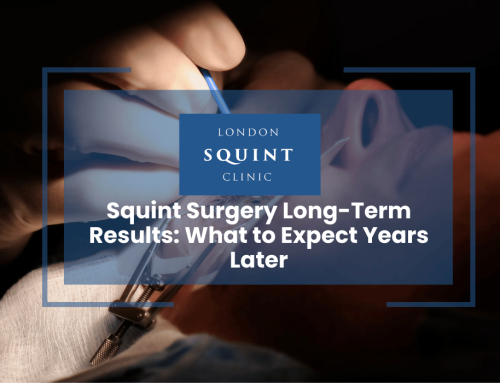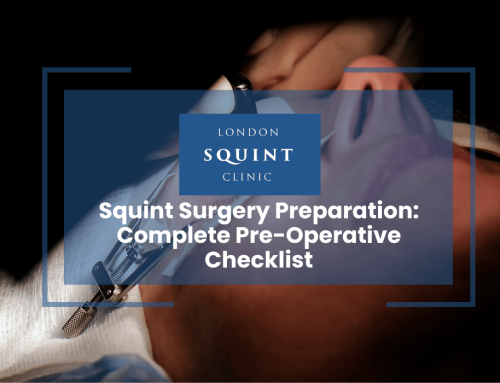Can Squint Return After Surgery? Causes and Prevention Tips
Managing and Preventing Squint Recurrence
- Squint recurrence affects 20-30% of patients after surgery, with rates varying by type: accommodative esotropia (10-15%), exotropia (25-40%), and vertical deviations (15%).
- Common causes of recurrence include incomplete initial correction, mechanical factors like scarring, neurological issues, and uncorrected refractive errors.
- Minor recurrence (less than 10 prism dioptres) often doesn’t require intervention, while larger recurrences may need reassessment and treatment.
- Critical postoperative care includes following medication schedules, attending all follow-up appointments, consistently wearing prescribed glasses, and observing activity restrictions.
- Vision therapy can reduce recurrence rates by 40-50% in suitable candidates by strengthening binocular vision and fusion reflexes.
- Lifestyle factors affecting long-term outcomes include digital device usage, sleep patterns, nutrition, stress management, and allergy control.
- Seek prompt consultation for warning signs like double vision, visual discomfort, behavioral changes in children, or visible changes in eye alignment.
- Prevention strategies include consistent wear of optical correction, maintenance exercises, proper ergonomics, and regular monitoring even years after successful surgery.
Table of Contents
- Understanding Squint Recurrence After Surgery: Facts and Figures
- Why Does Squint Return? Common Causes of Strabismus Relapse
- Is It Normal for Squint to Come Back After Successful Surgery?
- Critical Postoperative Care to Prevent Squint Recurrence
- Vision Therapy: Its Role in Maintaining Surgical Results
- Lifestyle Factors That Influence Long-Term Squint Correction
- When to Consult Your Squint Surgeon About Potential Relapse
- Prevention Strategies: Keeping Your Eyes Properly Aligned
Understanding Squint Recurrence After Surgery: Facts and Figures
Squint surgery (strabismus surgery) is highly effective, but patients often wonder about the possibility of recurrence. At London Squint Clinic, we believe in providing transparent information about long-term outcomes. Studies indicate that approximately 20-30% of patients may experience some degree of squint recurrence following initially successful surgery.
The recurrence rates vary significantly based on several factors. For accommodative esotropia (inward-turning eye), recurrence rates are typically lower at 10-15% when appropriate spectacle correction is maintained. Conversely, exotropia (outward-turning eye) shows higher recurrence rates of 25-40% over a 10-year follow-up period. Vertical deviations tend to have more stable long-term results with recurrence rates of approximately 15%.
Age is another critical factor influencing recurrence. Children under 4 years old have a higher risk of recurrence (up to 35%) compared to adults (15-20%). This difference is partly attributed to ongoing visual development and neurological changes in younger patients. Understanding these statistics helps set realistic expectations and emphasises the importance of long-term follow-up care after squint surgery.
Why Does Squint Return? Common Causes of Strabismus Relapse
Strabismus relapse can occur for various reasons, and understanding these factors is crucial for effective management. One primary cause is incomplete correction during the initial surgery. The complex balance of six extraocular muscles controlling each eye means that achieving perfect alignment can be challenging, particularly in complex cases with large-angle deviations or restrictive elements.
Mechanical factors also play a significant role in recurrent squint. Scarring and fibrosis of the eye muscles following surgery can alter the biomechanics of eye movement over time. This tissue remodelling process may continue for months or even years after surgery, gradually changing the eye’s position.
Neurological factors represent another important category. Persistent abnormalities in neural control mechanisms that govern binocular vision and eye alignment can lead to gradual drift in eye position. This is particularly relevant in patients with conditions like cranial nerve palsies or neurodevelopmental disorders.
Uncorrected refractive errors are a common yet preventable cause of recurrence. When patients have accommodative components to their squint but don’t wear prescribed glasses consistently, the eyes may revert to their misaligned position. Similarly, changes in refractive error over time, particularly in growing children, can trigger recurrence if not promptly addressed with updated spectacle prescriptions.
As we discuss in our detailed guide on how squint affects vision differently in adults and children, age-related factors can significantly influence long-term outcomes and recurrence patterns.
Is It Normal for Squint to Come Back After Successful Surgery?
While the term “normal” may not be entirely appropriate, it is certainly not uncommon for some degree of squint to return after initially successful surgery. Rather than viewing this as a failure, it’s more accurate to understand recurrence as part of the natural history of certain types of strabismus.
For intermittent exotropia (outward-turning eye that comes and goes), studies show that approximately 30% of patients may experience some recurrence within 5 years, even after excellent initial surgical outcomes. This pattern is so consistent that many squint surgeons now plan for this possibility during preoperative discussions.
The timing of recurrence varies by squint type. Esotropia (inward-turning eye) tends to show earlier signs of recurrence, often within the first 1-2 years post-surgery. Exotropia may demonstrate a more gradual drift, sometimes becoming noticeable only 3-5 years after surgery. Vertical deviations typically show greater stability, though changes can occur if there are underlying neurological or mechanical issues.
It’s important to distinguish between minor recurrence that may not require intervention and significant recurrence that impacts vision or causes symptoms. Small-angle recurrences of less than 10 prism dioptres often remain asymptomatic and may not warrant additional treatment. Larger recurrences, especially those causing double vision or affecting binocular function, typically benefit from reassessment and possibly further intervention.
Critical Postoperative Care to Prevent Squint Recurrence
Diligent postoperative care plays a crucial role in maintaining surgical results and minimising the risk of squint recurrence. The immediate recovery period (first 2-4 weeks) requires particular attention to prevent infection and promote proper healing. Patients should strictly adhere to prescribed antibiotic and anti-inflammatory eye drops, typically administered 4 times daily for 2-4 weeks.
Follow-up appointments are non-negotiable components of successful outcomes. The typical schedule includes assessments at 1 week, 1 month, 3 months, 6 months, and annually thereafter. These appointments allow for early detection of subtle changes in alignment before they progress to noticeable recurrence. Missing these check-ups significantly increases recurrence risk.
For patients with accommodative components to their squint, consistent use of prescribed spectacles is essential. Studies show that inconsistent spectacle wear is associated with a 3-fold increase in recurrence rates for accommodative esotropia. Parents of children with squint should ensure glasses are worn as directed, even if the eyes appear straight after surgery.
Activity restrictions during the healing phase are equally important. Patients should avoid swimming for at least 2 weeks and contact sports for 4-6 weeks. Excessive eye rubbing can disrupt healing and should be avoided. For children, parents may need to use protective shields during sleep for the first week to prevent inadvertent rubbing.
Monitoring for warning signs of recurrence—such as intermittent double vision, eye strain with prolonged visual tasks, or head tilting—enables early intervention. Patients should report these symptoms promptly rather than waiting for scheduled appointments.
Vision Therapy: Its Role in Maintaining Surgical Results
Vision therapy represents an important adjunctive treatment that can significantly enhance and maintain surgical outcomes for many squint patients. This specialised form of physical therapy for the visual system involves progressive exercises designed to improve binocular function, eye coordination, and visual processing.
For patients with convergence insufficiency or accommodative dysfunction, structured vision therapy programmes have demonstrated success rates of 70-80% in preventing recurrence when combined with surgical intervention. The therapy typically involves in-office sessions with a trained orthoptist or vision therapist, complemented by daily home exercises over a period of 12-16 weeks.
Specific exercises may include pencil push-ups, Brock string activities, stereograms, and computer-based vergence training. These exercises progressively challenge the visual system to maintain alignment and develop stronger fusion reflexes—the brain’s ability to blend images from both eyes into a single, three-dimensional perception.
Particularly beneficial for patients with intermittent strabismus, vision therapy helps strengthen the neural pathways responsible for maintaining proper alignment. Research indicates that patients who complete a structured vision therapy programme following surgery show a 40-50% reduction in recurrence rates compared to surgery alone.
It’s important to note that vision therapy is not equally effective for all types of squint. Patients with large-angle constant deviations or significant mechanical restrictions may benefit less from these approaches. A comprehensive assessment by your squint specialist will determine whether vision therapy is appropriate for your specific condition.
Lifestyle Factors That Influence Long-Term Squint Correction
Several lifestyle factors can significantly impact the long-term success of squint surgery and influence recurrence risk. Digital device usage has emerged as a particularly relevant factor in today’s technology-driven world. Prolonged screen time can exacerbate convergence insufficiency and accommodative dysfunction, potentially contributing to squint recurrence. Implementing the 20-20-20 rule (looking at something 20 feet away for 20 seconds every 20 minutes) can help reduce digital eye strain.
Sleep patterns also play a surprising role in maintaining eye alignment. Chronic sleep deprivation can affect the fine motor control of extraocular muscles and exacerbate intermittent deviations. Studies suggest that children who consistently get inadequate sleep show higher rates of intermittent exotropia progression. Establishing healthy sleep routines may therefore contribute to stable post-surgical outcomes.
Nutritional factors, while less directly studied, may influence healing and long-term tissue stability. Adequate vitamin C and protein intake supports collagen formation during the healing process. Omega-3 fatty acids may help reduce inflammation and promote optimal healing of the operated muscles.
Stress management deserves consideration as high stress levels can exacerbate certain types of intermittent strabismus. Techniques such as mindfulness, regular exercise, and adequate breaks during visually demanding tasks may help maintain stable alignment in susceptible individuals.
For patients with allergies, proper management is essential as chronic eye rubbing associated with allergic conjunctivitis can potentially affect surgical results. Using prescribed antihistamine drops and avoiding eye rubbing can help preserve surgical outcomes in these cases.
When to Consult Your Squint Surgeon About Potential Relapse
Recognising the early signs of squint recurrence and knowing when to seek professional assessment are crucial for timely intervention. Patients and parents should be vigilant for several key indicators that warrant prompt consultation with your squint surgeon.
Double vision (diplopia), even if intermittent or only occurring during specific activities or times of day, represents a significant warning sign. This symptom may begin subtly—perhaps only when tired or during particular gaze directions—before becoming more persistent. Any new onset of double vision following a period of stable single vision should prompt an appointment within 1-2 weeks.
Visual discomfort during specific activities provides another important clue. Symptoms such as eye strain, headaches after reading, or difficulty maintaining focus during close work may indicate subtle changes in eye alignment. These symptoms often precede visible misalignment and should not be dismissed.
For children, behavioural changes can signal recurrence. Increased clumsiness, difficulty catching balls, covering or closing one eye during visual tasks, or head tilting may indicate developing problems with binocular vision or alignment. Parents should document specific instances of these behaviours to discuss with the specialist.
Visible changes in eye alignment, particularly noticeable in photographs or reported by family members, obviously warrant assessment. However, it’s important to note that subtle recurrence may not be visible to casual observation but can still impact visual function significantly.
The timing of follow-up is crucial—patients experiencing any of these symptoms should not wait for their next scheduled appointment. Early intervention for recurrent squint often allows for less invasive management options and better outcomes.
Prevention Strategies: Keeping Your Eyes Properly Aligned
Implementing comprehensive prevention strategies significantly improves the long-term success of squint surgery. Consistent wear of prescribed optical correction forms the foundation of recurrence prevention. Even small uncorrected refractive errors can trigger recurrence, particularly in accommodative or partially accommodative squints. Patients should have annual refractive assessments to ensure their prescription remains optimal as refractive status can change over time.
Maintenance exercises prescribed by your orthoptist or vision therapist should be continued even after formal therapy concludes. Simple fusion exercises performed 2-3 times weekly can help maintain neural pathways for binocular vision. These might include pencil push-ups, Brock string exercises, or stereogram cards that can be easily incorporated into a regular routine.
Proper ergonomics during visual tasks plays a surprisingly important role in maintaining alignment. Computer screens should be positioned slightly below eye level at arm’s length. Reading material should be held at an appropriate distance (approximately 40cm) with adequate lighting. These adjustments reduce unnecessary strain on the extraocular muscles.
For patients with intermittent deviations, awareness of control techniques can be valuable. Learning to recognise the early sensations of an eye drifting and applying conscious control strategies (such as brief blinking, refocusing, or specific eye movements) can help maintain alignment during challenging visual situations.
Regular monitoring remains essential even years after successful surgery. Annual assessments allow for detection of subtle changes before they progress to symptomatic recurrence. These check-ups should include measurements of alignment in different gaze positions, assessment of fusion ranges, and evaluation of stereopsis (depth perception).
For patients with specific risk factors for recurrence—such as thyroid eye disease, myasthenia gravis, or history of multiple surgeries—more frequent monitoring may be recommended, typically every 4-6 months. This vigilant approach enables early intervention should signs of recurrence develop.
Frequently Asked Questions
How common is squint recurrence after surgery?
Squint recurrence affects approximately 20-30% of patients after initially successful surgery. Recurrence rates vary by squint type: accommodative esotropia has lower rates (10-15%), exotropia shows higher rates (25-40% over 10 years), and vertical deviations have more stable outcomes (around 15% recurrence). Children under 4 years have higher recurrence risk (up to 35%) compared to adults (15-20%).
What causes squint to return after successful surgery?
Squint recurrence can be caused by incomplete correction during initial surgery, mechanical factors like scarring and fibrosis of eye muscles, persistent neurological control abnormalities, uncorrected or changing refractive errors, inconsistent use of prescribed glasses, and age-related factors. The complex interaction of six extraocular muscles per eye makes perfect long-term alignment challenging in some cases.
How long after squint surgery can recurrence happen?
Squint recurrence timing varies by type. Esotropia (inward-turning eye) typically shows signs of recurrence within 1-2 years post-surgery. Exotropia (outward-turning eye) often demonstrates a more gradual drift, becoming noticeable 3-5 years after surgery. Some patients may experience changes even 5-10 years following initially successful treatment, highlighting the importance of long-term follow-up.
What are the early warning signs of squint recurrence?
Early warning signs of squint recurrence include intermittent double vision (especially when tired), visual discomfort during specific activities (reading, screen use), eye strain or headaches with visual tasks, difficulty maintaining focus, behavioral changes in children (covering one eye, head tilting, decreased coordination), and subtle changes in eye alignment noticed in photographs or by family members.
Can vision therapy prevent squint from returning after surgery?
Vision therapy can significantly reduce squint recurrence rates when used as a complement to surgery. For conditions like convergence insufficiency or accommodative dysfunction, structured vision therapy shows 70-80% success in preventing recurrence. Patients who complete post-surgical vision therapy programs demonstrate a 40-50% reduction in recurrence compared to surgery alone. However, effectiveness varies by squint type and is less beneficial for large-angle constant deviations.
Does wearing glasses after squint surgery reduce recurrence risk?
Yes, consistent use of prescribed glasses significantly reduces squint recurrence risk, especially for accommodative esotropia. Studies show inconsistent spectacle wear increases recurrence rates three-fold. Even after successful surgery, patients should continue wearing their prescribed correction and have annual refractive assessments, as even small uncorrected refractive errors can trigger recurrence.
If squint returns, will I need another surgery?
Not all recurrent squints require additional surgery. Small-angle recurrences (less than 10 prism diopters) often remain asymptomatic and may be managed with non-surgical approaches like vision therapy, prism glasses, or observation. Larger recurrences causing double vision or affecting binocular function typically benefit from surgical intervention. The decision depends on symptom severity, degree of misalignment, and individual factors that your squint specialist will evaluate.
Find out if you are suitable for Double Vision Treatment
Not everyone is eligible for double vision surgery.
Find out if you could benefit from this life-changing surgery by taking the quick self-suitability quiz below:
Our most popular procedures

Hello, I’m Nadeem Ali
I’m one of the few eye surgeons in the world with 100% focus on Squint and Double Vision Surgery.
I have 24 years of eye surgery experience, and worked for 13 years as a Consultant at London’s renowned Moorfields Eye Hospital.
In 2023, I left the NHS to focus fully on treating patients from across the world at the London Squint Clinic. You can read more about me here.
There’s lots of information on the website about: squint surgery, double vision surgery and our pricing.
The most rewarding part of my job is hearing patients tell me how squint or double vision surgery has changed their lives. You can hear these stories here.
Mr Nadeem Ali
MA MB BChir MRCOphth FRCSEd(Ophth)





